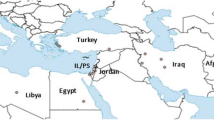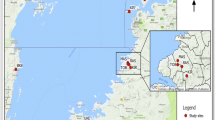Abstract
Haematobia irritans is a hematophagous parasite of cattle that causes significant economic losses in many parts of the world, including Brazil. In the present work, one American, four Brazilian populations of this species were studied by Random Amplified Polymorpht DNA (RAPD) to assess basically genetic variability within and between populations. Ten different decamer random primers were employed in the genomic DNA amplification, yielding 117 fragments in the five H. irritans populations. In Drosophila prosaltans, used as an outgroup, 81 fragments were produced. Forty-three of these fragments were shared by both species. Among the H. irritans samples, that from Rio Branco (Acre State, Brazil) produced the smallest numbers of fragments, polymorphic bands. This high genetic homogenity may be ascribed to its geographic origin (in the Northwest of Brazil), which causes high isolation, low gene flow, unlike the other Brazilian populations, from the South Central region, in which cattle trade is very intensive. Marker fragments (exclusive bands) detected in every sample enabled the population origin to be characterized, but they are also potentially useful for further approaches such as the putative origin of Brazilian populations from North America. Similarity indices [Nei & Li, 1979, Proc. Natl. Acad. Sci. USA 76: 5269–5273], phylogenetic trees, rooted by using the outgroup, produced by the Phylogenetic Analysis using Parsimony (PAUP 4.0-Swofford, 2001) program showed the closest relationships between flies from São José do Rio Preto, Turiúba (both from São Paulo State, Brazil) while flies from the geographically distant Rio Branco showed the greatest differentiation relative to the others.
Similar content being viewed by others
References
E.C. Borges J.P. Dujardin C.J. Schofield A.J. Romanha (2000) ArticleTitleGenetic variability of Triatoma brasiliensis populations J. Med. Entomol. 7 872–877
R. Bournoville J.C. Simon I. Badenhausser C. Girousse T. Guillox S. Andre (2000) ArticleTitleClones of pea aphid distinguished using genetic markers, differ in their damaging effect on a resistant alfafa cultivar Bull. Entomol. Res. 90 33–39 Occurrence Handle1:STN:280:DC%2BD3M%2FhvFWjsw%3D%3D Occurrence Handle10948361
L.F. Cabrita U. Aksoy S. Hepaksoy J.M. Leitão (2001) ArticleTitleSuitability of isozyme, RAPD, AFPL markers to assess genetic differences, relatedness among fig (Ficus carica L) clones Sci. Horticult. 87 261–273 Occurrence Handle10.1016/S0304-4238(00)00181-3 Occurrence Handle1:CAS:528:DC%2BD3MXpsVGitg%3D%3D
J.B. Campbell G.D. Thomas (1992) ArticleTitleThe history, biology, economics, control of the horn fly, Haematobia irritans Agric. Pract 13 IssueID4 31–36
L. Castiglioni-Ruiz H.E.M.C. Bicudo C.R. Ceron (1997) ArticleTitleEsterase patterns in four Brazilian populations of Haematobia irritans Cytobios 90 81–94 Occurrence Handle1:CAS:528:DyaK1cXhs1agu7k%3D Occurrence Handle9474771
J.P. Castro L. Madi-Ravazzi (2000) ArticleTitleRAPD as genetic marker in taxonomic, evolutionary studies in the Drosophila buzzatii cluster Dros. Inf. Serv. (DIS) 83 26–32
P.P. Chong Y.L. Lee B.C. Tan K.P. Ng (2003) ArticleTitleGenetic relatedness of Candida strains isolated from women with vaginal candidiasis in Malaysia J. Med. Microbiol. 52 657–666 Occurrence Handle10.1099/jmm.0.04973-0 Occurrence Handle1:CAS:528:DC%2BD3sXntlKht78%3D Occurrence Handle12867559
Cupp, E., M. Cupp, D. Zhang, 2002. Vaccine against horn flies could curb economic losses. NRI Res. Highlights 3 (http://www.reeusda.gov/nri).
S.L. Dellaporta J. Wood J.B. Hicks (1983) ArticleTitleA plant DNA minipreparation: version II Plant Mol. Biol. Rep. 1 19–21 Occurrence Handle1:CAS:528:DyaL2cXksFWhtrk%3D
G. Dimopoulos L. Zheng V. Kumar A. della Torre F.C. Kafatos C. Louis (1996) ArticleTitleIntegrated genetic map of Anopheles gambiae: use of RAPD polymorphisms for genetic, cytogenetic, STS landmarks Genetics 143 953–960 Occurrence Handle1:CAS:528:DyaK28XjvV2htLs%3D Occurrence Handle8725241
B. Ding H. Li Y. Zhang Z. Liu Y. Wei (2000) ArticleTitleTaxonomic status of the White–head Langur (Trachypithecus francoisi leucoscephalus) inferred from allozyme electrophoresis, random amplified polymorphic DNA (RAPD) Zool. Stud. 39 313–318 Occurrence Handle1:CAS:528:DC%2BD3cXptVCls7s%3D
R.O. Drummond J.E. George S.E. Kunz (1988) Control of arthropod pests of livestock: a review of technology CRC Press Boca Raton, FL 245
G. Favia G. Dimopoulos C. Louis (1994) ArticleTitleAnalysis of the Anopheles gambiae genome using RAPD markers Insect Mol. Biol. 3 149–157 Occurrence Handle1:CAS:528:DyaK2MXitValurk%3D Occurrence Handle7894747
C. Fu Y. Qiu H. Kong (2003) ArticleTitleRAPD analysis for genetic diversity in Changium smyrnioides (Apiaceae), an endangered plant Bot. Bull. Acad. Sinica 44 13–18 Occurrence Handle1:CAS:528:DC%2BD3sXit1Gltr4%3D
F.D. Guerrero R.C. Jamroz D. Kammlah S.E. Kunz (1997) ArticleTitleToxicological, molecular characterization of pyrethroid-resistant horn flies, Haematobia irritans: identification of kdr, super-kdr point mutations Insect Biochem. Mol. Biol. 27 745–755 Occurrence Handle10.1016/S0965-1748(97)00057-X Occurrence Handle1:CAS:528:DyaK1cXktlWgtw%3D%3D Occurrence Handle9443375
A.A. Guglielmone E. Gimeno J. Idiart (1999) ArticleTitleSkin lesions, cattle hide damage from Haematobia irritans infestations J. Med. Entomol. 13 324–329 Occurrence Handle10.1046/j.1365-2915.1999.00167.x Occurrence Handle1:STN:280:DyaK1Mvkt1aiug%3D%3D
A.A. Guglielmone M.M. Volpogni N. Scherling M.M. Cobenas A.J. Mangold (2000) ArticleTitleChlorfenapyr ear tags to control Haematobia irritans on cattle Vet. Parasitol. 93 77–82 Occurrence Handle10.1016/S0304-4017(00)00335-6 Occurrence Handle1:CAS:528:DC%2BD3cXntF2qs70%3D Occurrence Handle11027863
T. Hatanaka P.M. Galetti SuffixJr. (2003) ArticleTitleRAPD markers indicate the occurrence of structured populations in a migratory freshwater fish species Genet. Mol. Biol. 26 19–25 Occurrence Handle10.1590/S1415-47572003000100004 Occurrence Handle1:CAS:528:DC%2BD3sXjslSmt7c%3D
D.S. Haymer D.O. McInnis (1994) ArticleTitleResolution of populations of the Mediterranean fruit fly at the DNA level using random primers for the polymerase chain reaction Genome 37 244–248 Occurrence Handle1:CAS:528:DyaK2cXmvFeru7w%3D Occurrence Handle8200514
P. Hernadez A. Martin G. Dorado (1999) ArticleTitleDevelopment of SCARS by direct sequencing of RAPD products: a practical tool for the introgression, marker-assisted selection of wheat Mol. Breeding 5 245–253 Occurrence Handle10.1023/A:1009637928471
K.Y. Ho C.H. Ou J.C. Yang J.Y. Hsiao (2002) ArticleTitleAn assessment of DNA polymorphisms, genetic relationships of Casuarina equisetifolia using RAPD markers Bot. Bull. Acad. Sinica 43 93–98 Occurrence Handle1:CAS:528:DC%2BD38XovFaitbc%3D
N.N. Jonsson D.G. Mayer (1999) ArticleTitleEstimation of the effects of buffalo fly on the milk production of dairy cattle based on a meta-analysis of literature data Med. Vet. Entomol. 13 IssueID4 372–376 Occurrence Handle10.1046/j.1365-2915.1999.00179.x Occurrence Handle1:STN:280:DC%2BD3c%2Fntl2jtg%3D%3D Occurrence Handle10608225
P.E. Kaufman J.E. Lloyd R. Kumar (1999) ArticleTitleHorn fly susceptibility to diazinon, fenthion, permethrin at selected elevations in Wyoming J. Agric. Urban Entomol. 16 141–157 Occurrence Handle1:CAS:528:DC%2BD3cXhvFWjsg%3D%3D
S.E. Kunz J.A. Miller P.L. Sims D.C. Meyerhoeffer (1984) ArticleTitleEconomics of controlling horn flies (Diptera: Muscidae) in range cattle management J. Econ. Entomol. 77 657
A.S. Lapenta H.E.M.C. Bicudo C.R. Ceron J.A. Cordeiro (1995) ArticleTitleEsterase patterns of species in the Drosophila buzzatii cluster Cytobios 84 13–29 Occurrence Handle1:CAS:528:DyaK28XkvVequ78%3D Occurrence Handle8681607
A.R.A. Lima-Catelani C.R. Ceron H.E.M.C. Bicudo (2004) ArticleTitleGenetic variation during development, revealed by esterase patterns of Aedes aegypti Biochem. Genet. 42 70–84
Marcondes C.B. (2001). Entomologia Médica e Veterinária, 432 pp. Ed. Atheneu, São Paulo
L.E. Myers S.U.P.S. Silva J.D. Procunier P.B. Little (1999) ArticleTitleGenomic fingerprinting of Haemophilus somnus isolates by using a RAPD assay J. Clin. Microbiol. 32 512–517
A.P. Nascimento H.E.M.C. Bicudo (2002) ArticleTitleEsterase patterns, phylogenetic relationships of Drosophila species in the saltans subgroup (saltans group) Genetica 114 41–51 Occurrence Handle10.1023/A:1014672502359 Occurrence Handle1:CAS:528:DC%2BD38XjslCku7s%3D Occurrence Handle11990758
M. Nei W.H. Li (1979) ArticleTitleMathematical model for studying genetic variation in terms of restriction endonucleases Proc. Natl. Acad. Sci. USA. 76 5269–5273 Occurrence Handle1:CAS:528:DyaL3cXitVWn Occurrence Handle291943
J.H. Pruett D.D. Oehler D.M. Kammlah F.D. Guerrero (2000) ArticleTitleEvaluation of horn fly from a pyrethroid susceptible colony for general, permethrin esterase activities J. Econ. Entomol. 93 920–924 Occurrence Handle1:CAS:528:DC%2BD3cXkvFOmsb0%3D Occurrence Handle10902350
A. Reineke C.P. Zebitz (1999) ArticleTitleSuitability of polymerase chain reaction-based approaches for identification of different gypsy moth genotypes in central Europe.Ann. Entomol Soc. Am. 92 737–741 Occurrence Handle1:CAS:528:DyaK1MXmvVWitrY%3D
A. Reyes M.D. Ochando (1998) ArticleTitleUse of molecular markers for detecting the geographical origin of Ceratitis capitata populations Ann. Entomol. Soc. Am. 91 222–227 Occurrence Handle1:CAS:528:DyaK1cXivFSmtr0%3D
M.A. Scataglini V.A. Confalonieri A.A. Lanteri (2000) ArticleTitleDispersal of the cotton boll weevil in South America: evidence of RAPD analysis Genetica 108 127–136 Occurrence Handle10.1023/A:1004163820446 Occurrence Handle1:CAS:528:DC%2BD3MXkvVyktA%3D%3D Occurrence Handle11138940
T. Sera P.M. Ruas C.F. Ruas L.E.C. Diniz V.P. Carvalho L. Rampim E.A. Ruas S.R. Silveira (2003) ArticleTitleGenetic polymorphism among 14 elite Coffea arabica L. cultivars using RAPD markers associated with restriction digestion Genet. Mol. Biol. 26 59–64 Occurrence Handle10.1590/S1415-47572003000100010 Occurrence Handle1:CAS:528:DC%2BD3sXjslSmtLk%3D
G.B. Sousa A. Blanco C.N. Gardenal (2001) ArticleTitleGenetic relationships among Aedes aegypti populations from Argentina using RAPD-PCR Genetica 108 127–136
R.G.M. Spada D. Silva Particleda A.Z. Abdel-Hamid S.S. Sobral-Hamaguchi N.R.B. Zuim E.M. Zanott L.A. Magalhães J.T. Ribeiro-Paes (2002) ArticleTitleGenetic markers between Biomphalaria glabratasnails susceptible, resistant to Schistoson infection Mem. Inst. Oswaldo Cruz 97 53–58 Occurrence Handle10.1590/S0074-02762002000900012 Occurrence Handle1:CAS:528:DC%2BD38XoslGjtLo%3D
Swofford D.L. (2001). PAUP 4.0 – Phylogenetic Analysis Using Parsimony. Beta Version. Executable for Windows Systems
Valério, J.R. 1985. Haematobia irritans L. Um novo problema para a bovinocultura no Brasil. Comunicado Técnico Embrapa 25. Available in the site http://.cnpgc.embrapa. br/publicacoes/cot/COT25.html
J. Welsh M. McClelland (1990) ArticleTitleFingerprinting genomes using PCR with arbitrary primers Nucleic Acids Res. 18 213–7218
C.L. Williams S.L. Goldson D.B. Baird D.W. Bullock (1994) ArticleTitleGeographical origin of an introduced pest, L. bonariensis, determined by RAPD analysis Heredity 72 412–419 Occurrence Handle8200816
J.G.K. Williams A.R. Kubelik K.J. Livak J.A. Rafaslki S.V. Tingey (1990) ArticleTitleDNA polymorphisms amplified by arbitrary primers are useful as genetic markers Nucleic Acids Res. 18 6531–6535 Occurrence Handle1:CAS:528:DyaK3MXjslWmsA%3D%3D Occurrence Handle1979162
Zeng, L., W.V. Baird, J.A. Dusky, 1996. Identification of a molecular marker linked to dinitroaniline herbicide resistance in goosegrass. Proceedings of the Southern Weed Science Society 49th annual meeting. Charlotte, North Carolina, USA, pp. 141–145
Author information
Authors and Affiliations
Corresponding author
Rights and permissions
About this article
Cite this article
Castiglioni, L., Bicudo, H.E.M.d.C. Molecular characterization, relatedness of Haematobia irritans (horn fly) populations, by RAPD-PCR. Genetica 124, 11–21 (2005). https://doi.org/10.1007/s10709-004-4309-0
Received:
Accepted:
Issue Date:
DOI: https://doi.org/10.1007/s10709-004-4309-0




